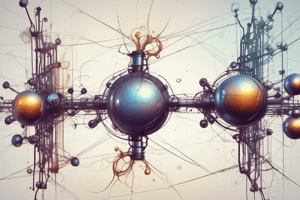Podcast
Questions and Answers
What can reactive metals do in a solution or molten form?
What can reactive metals do in a solution or molten form?
- React with all metals in the solution
- Form compounds with non-reactive metals
- Displace less reactive metals from their compounds (correct)
- React with oxygen, water, and acid
Why is it not possible to arrange all metal samples collectively in decreasing order of reactivity?
Why is it not possible to arrange all metal samples collectively in decreasing order of reactivity?
- The reactivity of metals changes in a solution
- Some metals react only with oxygen
- Not all metals react with oxygen, water, and acid (correct)
- All metals have similar reactivity
What does the displacement reaction of solution P give rise to?
What does the displacement reaction of solution P give rise to?
- Solution of B + Metal A
- Solution of A + Metal P
- Solution of A + Metal B (correct)
- Solution of P + Metal A
What can reactive metals do in a solution or molten form?
What can reactive metals do in a solution or molten form?
Why is it not possible to arrange all metal samples collectively in decreasing order of reactivity?
Why is it not possible to arrange all metal samples collectively in decreasing order of reactivity?
What does the displacement reaction of solution P give rise to?
What does the displacement reaction of solution P give rise to?
Flashcards are hidden until you start studying
Study Notes
Reactive Metals in Solution or Molten Form
- Reactive metals can easily lose electrons when in solution or molten form, allowing them to participate in chemical reactions.
- They can displace less reactive metals from their compounds, demonstrating their high reactivity.
- The presence of ions in solution enhances their ability to conduct electricity and participate in electrochemical processes.
Difficulty in Ordering Metal Reactivity
- Reactivity varies based on specific conditions such as temperature, concentration, and the state of the metal (solid, liquid, or gas).
- Some metals might react in unexpected ways with different substances, complicating a straightforward reactivity hierarchy.
- The complexity of metal interactions with nonmetals and solvents means that a universal reactivity series cannot be easily established for all metals.
Displacement Reaction from Solution P
- The displacement reaction from solution P can lead to the formation of new compounds as more reactive metals replace less reactive ones.
- A noticeable observation often occurs, such as the production of a gas or the formation of a precipitate, which indicates the occurrence of a chemical reaction.
- This reaction’s result showcases the principles of metal reactivity and the ability to predict how different metals will interact in solution.
Studying That Suits You
Use AI to generate personalized quizzes and flashcards to suit your learning preferences.




